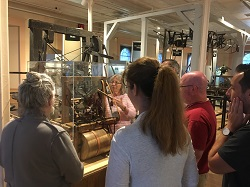Guest Post by Lori Austin: A personal reflection on the Industrial Revolution by a 4th grade teacher
Over the summer of 2019, 70 teachers participated in an immersive NEH-funded Emerging America workshop exploring transformational innovation in Springfield, MA and up and down the Connecticut River Valley. Teachers learned about causes and consequences of precision manufacturing processes invented here. On this Labor Day, we publish Lori Austin’s thoughts on how this workshop helped her gain personal connections to the past. Austin and her students at Gabriel Abbott Memorial Elementary School have created two local history websites, one on Chinese workers in North Adams, Massachusetts, and A Visual History of the Mohawk Trail. http://emergingamerica.org/programs/windows-history/student-websites
To be honest, I knew little about the Industrial Revolution other than that it was the transition from material produced by individuals in their homes to a factory, assembly-line production model. Agricultural life to factory life. I really never gave it much more thought.
After this workshop, I now realize that I spent most of my childhood surrounded by relatives who were part of this revolution. These included my paternal grandmother, an immigrant from Wales, who lost her finger in an accident working in a garment factory, my maternal grandfather who retired after 40 years at Bullards machine shop–and where my parents first met, to a half-dozen aunts and uncles who worked in manufacturing under defense contracts in places like Sikorsky Helicopter, Pratt and Whitney, Remington Arms, and Norton Machines.
I grew up in Bridgeport, CT, and my bedroom window was about 50 feet from a large factory, Bridgeport Machines. I remember talking through the windows to the workers on their breaks. Never once did I wonder what was going on in these loud, smelly and somewhat scary factory floors. Perhaps the daily grind was something my relatives wanted to leave on the factory floor.
After taking this class I so wish I could go back in time and ask these relatives what they did, how they contributed to the development and innovations that shaped the country I grew up in.
Over the course of the week I often thought back on my grandmother, Agnes Hughes, who worked in the packing department at the Warner Brothers Company in my hometown of Bridgeport. I often wondered about how she had lost her finger but when asked all she would say was, “I lost it in a machine at Warners.” My young mind conquered up an image of a machine monster that ate fingers. Perhaps I wasn’t too off the mark. The following passage from Carrie Brown’s book, Rosie’s Mom, really struck home.
- Standing all day at long tables in dusty rooms, with the strong smell of glue filling the air, the workers brushed paste on the cardboard and folded the shaped boxes...Then another group, stationed at cutting machines, trimmed off the ends of the muslim strips. This was the routine: hold the box in place; grasp it firmly so it cannot slip; press on the treadle to bring the blade down, and cut off the excess muslim; remove the box and quickly put another in place; then press the treadle again.
I see now that the Industrial Revolution wasn’t really a revolution, but rather a gradual networking of craftsmen, farmers, innovators, scientists, workers, and common folk who saw the need for change and went for it. Just as in a machine, the parts and people may have been interchangeable but working together, they pushed this country to be the manufacturing center of the world. Now let’s hope a new generation is up for the task once again.
My grandmother helped me make a connection to the industrial revolution, and it is my hope that I can do the same for my students. My lesson plans will take my students out of the classroom and into the past–exploring the 1890-1920 lives of the workers at a local textile mill, with emphasis on the children that worked there. I might not have asked the many questions I now have to my relatives, but I will help my 4th and 5th graders learn how to ask and answer questions regarding the industrial revolution and the countless souls that labored to make it happen.
- Brown, Carrie. Rosie’s Mom: Forgotten Women Workers of the First World War. Boston, MA: Northeastern University Press 2002.




